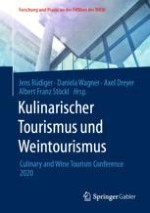2021 | OriginalPaper | Chapter
4. Kenne deinen Gast: Segmentierung von Wiener Kaffeehausgästen anhand der „culinary experience“ am Beispiel eines traditionellen Familienbetriebs/Know Your Guest: Segmentation of Viennese Coffee House Guests Based on the “Culinary Experience” Using the Example of a traditional family business
Authors : Petra Binder, Klaus-Peter Fritz, Julia Pöchacker
Published in: Kulinarischer Tourismus und Weintourismus
Publisher: Springer Fachmedien Wiesbaden
Activate our intelligent search to find suitable subject content or patents.
Select sections of text to find matching patents with Artificial Intelligence. powered by
Select sections of text to find additional relevant content using AI-assisted search. powered by
